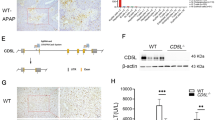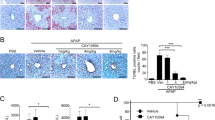Abstract
Profound hepatocellular injury is often a consequence of adenovirus-mediated gene therapy or acetaminophen ingestion. The aim of the present study was to examine the role of a CXC chemokine, macrophage inflammatory protein-2 (MIP-2), in the hepatotoxic response by mice infected with adenovirus and challenged with acetaminophen. CD1 mice that received a replication-defective human type 5 adenovirus vector (Ad70-3) intravenously exhibited hepatic injury that peaked at 24 h after infection. In contrast, mice that received a similar adenovirus vector containing a rodent MIP-2 cDNA insert had no hepatic injury at any time after infection. The combination of Ad70-3 infection and an intraperitoneal challenge with 400 mg/kg of acetaminophen was fatal in 50% of the mice, but only 10% of the AdMIP-2 group receiving acetaminophen were similarly affected. Furthermore, AdMIP-2 mice had significantly lower hepatic injury and serum aminotransaminases compared with the Ad70-3 group. However, AdMIP-2 infection in mice lacking the CXC chemokine receptor that binds MIP-2, CXCR2, did not attenuate any of the markers of liver injury after adenovirus and acetaminophen challenge. AdMIP-2 treatment of CD1 mice was also associated with significantly decreased leukocyte infiltration into the liver and an earlier increase in hepatic 3H-thymidine incorporation compared with the control group. Taken together, these data demonstrate that MIP-2 has a protective role in both adenovirus- and acetaminophen-mediated hepatotoxicity, and suggest that MIP-2 may promote rapid hepatic regeneration following acute hepatic injury.
This is a preview of subscription content, access via your institution
Access options
Subscribe to this journal
Receive 12 print issues and online access
$259.00 per year
only $21.58 per issue
Buy this article
- Purchase on Springer Link
- Instant access to full article PDF
Prices may be subject to local taxes which are calculated during checkout










Similar content being viewed by others
References
Yang Y et al. Immune responses to viral antigens versus transgene product in the elimination of recombinant adenovirus-infected hepatocytes in vivo Gene Therapy 1996 3: 137–144
Nielsen LL et al. Recombinant E1-deleted adenovirus-mediated gene therapy for cancer: efficacy of studies with p53 tumor suppressor gene and liver histology in tumor xenograft models Hum Gen Ther 1998 9: 681–694
Bao JJ, Zhang WW, Kuo MT . Adenovirus delivery of recombinant DNA into transgenic mice bearing hepatocellular carcinomas Hum Gene Ther 1996 7: 355–365
Castell JV et al. Adenovirus-mediated gene transfer into human hepatocytes: analysis of the biochemical functionality of transduced cells Gene Therapy 1997 4: 455–464
Raper SE, Wilson JM . Gene therapy for human liver disease Prog Liver Dis 1995 13: 201–230
Yang Y et al. Transient subversion of CD40 ligand function diminishes immune responses to adenovirus vectors in mouse liver and lung tissues J Virol 1996 70: 6370–6377
Kay MA et al. Transient immunomodulation with anti-CD40 ligand antibody and CTLA4Ig enhances persistence and secondary adenovirus-mediated gene transfer into mouse liver Proc Natl Acad Sci USA 1997 94: 4686–4691
Sullivan DE et al. Liver-directed gene transfer in non-human primates Hum Gene Ther 1997 8: 1195–1206
Kwan D, Bartle WR, Walker SE . Abnormal serum transaminases following therapeutic doses of acetaminophen in the absence of known risk factors Dig Dis Sci 1995 40: 1951–1955
Alison MR, Golding M, Sarraf CE . Liver stem cells: when the going gets tough they get going Int J Exp Path 1997 78: 365–381
Kay MA, Fausto N . Liver regeneration: prospects for therapy based on new technologies Mol Med Today 1997 3: 108–115
Louis H et al. Hepatoprotective role of interleukin 10 in galactosamine/ lipopolysaccharide mouse liver injury Gastroenterology 1997 112: 935–942
Bruccoleri A et al. Induction of early–immediate genes by tumor necrosis factor alpha contribute to liver repair following chemical-induced hepatotoxicity Hepatology 1997 25: 133–141
Renic M et al. The effect of interleukin-1 alpha on acetaminophen-induced hepatotoxicity Cytokine 1993 5: 192–197
Tiggelman AM et al. Interleukin-6 production by human liver (myo)fibroblasts in culture. Evidence for a regulatory role of LPS, IL-1 beta and TNF alpha J Hepatol 1995 23: 295–306
Trautwein C et al. Concanavalin A-induced liver injury triggers hepatocyte proliferation J Clin Invest 1998 101: 1960–1969
Strieter RM et al. ‘The good, the bad, and the ugly.’ The role of chemokines in models of human disease J Immunol 1996 156: 3583–3586
Lentsch AB et al. Chemokine involvement in hepatic ischemia/reperfusion injury in mice: roles for macrophage inflammatory protein-2 and KC (corrected and republished article originally printed in Hepatology 1998; 27: 507–512) Hepatology 1998 27: 1172–1177
Bautista AP . Chronic alcohol intoxication induces hepatic injury through enhanced macrophage inflammatory protein-2 production and intercellular adhesion molecule-1 expression in the liver Hepatology 1997 25: 335–342
Sprenger H et al. Induction of neutrophil-attracting chemokines in transforming rat hepatic stellate cells Gastroenterology 1997 113: 277–285
Takada H et al. Chemotactic factors released from hepatocytes exposed to acetaminophen Dig Dis Sci 1995 40: 1831–1836
Foley R et al. Adenoviral gene transfer of macrophage inflammatory protein-2 in rat lung Am J Pathol 1996 149: 1395–1403
Bell MD et al. Recombinant human adenovirus with rat MIP-2 gene insertion causes prolonged PMN recruitment to the murine brain Eur J Neurosci 1996 8: 1803–1811
Davern TJ, Scharschmidt BF . Gene therapy for liver disease Dig Dis 1998 16: 23–37
Farrell GC . Drug-induced hepatic injury J Gastroenterol Hepatol 1997 12: S242–S250
Fahey TJD et al. Cytokine production in a model of wound healing: the appearance of MIP-1, MIP-2, cachectin/TNF and IL-1 Cytokine 1990 2: 92–99
Huard J et al. The route of administration is a major determinant of the transduction efficiency of rat tissues by adenoviral recombinants Gene Therapy 1995 2: 107–115
Peeters MJ et al. Adenovirus-mediated hepatic gene transfer in mice: comparison of intravascular and biliary administration Hum Gene Ther 1996 7: 1693–1699
Vickers SM et al. In vivo gene transfer to the human biliary tract Gene Therapy 1996 3: 825–828
Bernal W et al. Use and outcome of liver transplantation in acetaminophen-induced acute liver failure Hepatology 1998 27: 1050–1055
Makin AJ, Williams R . Acetaminophen-induced hepatotoxicity: predisposing factors and treatments Adv Intern Med 1997 42: 453–483
Heubi JE, Barbacci MB, Zimmerman HJ . Therapeutic misadventures with acetaminophen: hepatotoxicity after multiple doses in children J Pediatr 1998 132: 22–27
Lores Arnaiz S et al. Oxidative stress by acute acetaminophen administration in mouse liver Free Rad Biol Med 1995 19: 303–310
Blazka ME et al. Role of proinflammatory cytokines in acetaminophen hepatotoxicity Toxicol Appl Pharmacol 1995 133: 43–52
Whitcomb DC, Block GD . Association of acetaminophen hepatotoxicity with fasting and ethanol use JAMA 1994 272: 1845–1850.
Chanda S et al. Stimulated hepatic tissue repair underlies heteroprotection by thioacetamide against acetaminophen-induced lethality Hepatology 1995 21: 477–486
Arsura M et al. Nuclear factor-kappaB/Rel blocks transforming growth factor beta1-induced apoptosis of murine hepatocyte cell lines Cell Growth Diff 1997 8: 1049–1059
Frevert CW et al. Functional characterization of rat chemokine macrophage inflammatory protein-2 Inflammation 1995 19: 133–142
Cacalano G et al. Neutrophil and B cell expansion in mice that lack the murine IL-8 receptor homolog Science 1994 265: 682–684
Lee J et al. Chemokine binding and activities mediated by the mouse IL-8 receptor J Immunol 1995 155: 2158–2164
Kulke R et al. The CXC receptor 2 is overexpressed in psoriatic epidermis J Invest Dermatol 1998 110: 90–94
Sanchez X et al. CXC chemokines suppress proliferation of myeloid progenitor cells by activation of the CXC chemokine receptor 2 J Immunol 1998 160: 906–910
Evanoff H et al. A sensitive ELISA for the detection of human monocyte chemoattractant protein-1 (MCP-1) Immunol Invest 1992 21: 39–49
Pessayre D et al. Effect of fasting on metabolite-mediated hepatotoxicity in the rat Gastroenterology 1979 77: 264–271
Manautou JE et al. Protection by clofibrate against acetaminophen hepatotoxicity in male CD-1 mice is associated with an early increase in biliary concentration of acetaminophen-glutathione adducts Toxicol Appl Pharmacol 1996 140: 30–38
Casley WL et al. Differences in caffeine 3-demethylation activity among inbred mouse strains: a comparison of hepatic Cyp1a2 gene expression between two inbred strains Fund Appl Toxicol 1997 40: 228–237
Colletti LM et al. Chemokine expression during hepatic ischemia/reperfusion-induced lung injury in the rat. The role of epithelial neutrophil activating protein J Clin Invest 1995 95: 134–141
Greenberger MJ et al. Neutralization of macrophage inflammatory protein-2 attenuates neutrophil recruitment and bacterial clearance in murine Klebsiella pneumonia J Infect Dis 1996 173: 159–165
Hogaboam CM et al. Therapeutic effects of interleukin-4 gene transfer in experimental inflammatory bowel disease J Clin Invest 1997 100: 2766–2776
Author information
Authors and Affiliations
Rights and permissions
About this article
Cite this article
Hogaboam, C., Simpson, K., Chensue, S. et al. Macrophage inflammatory protein-2 gene therapy attenuates adenovirus- and acetaminophen-mediated hepatic injury. Gene Ther 6, 573–584 (1999). https://doi.org/10.1038/sj.gt.3300858
Received:
Accepted:
Published:
Issue Date:
DOI: https://doi.org/10.1038/sj.gt.3300858
Keywords
This article is cited by
-
The Effect of Simvastatin on Pulmonary Damage in Experimental Peritonitis in Rats
Indian Journal of Surgery (2015)
-
Idiosyncratic drug hepatotoxicity
Nature Reviews Drug Discovery (2005)



